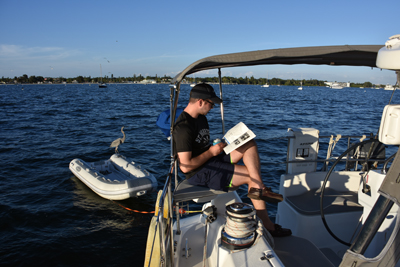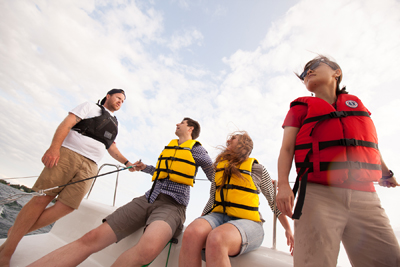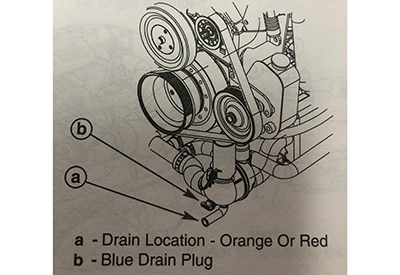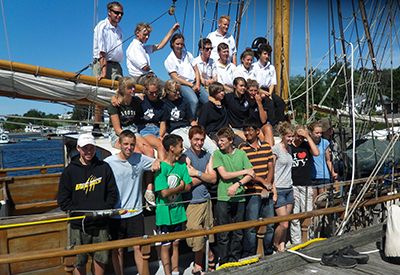Man Overboard
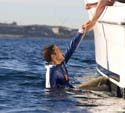
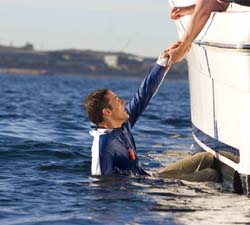 An accident that occurs with surprising frequency to passengers and crew is falling. The chance of this happening can be greatly reduced if precautions are taken, such as wearing non-skid shoes that lace up and wearing appropriate clothing that does not impede movement. Those on board should make sure they have a sound footing and a good handhold at all times.
An accident that occurs with surprising frequency to passengers and crew is falling. The chance of this happening can be greatly reduced if precautions are taken, such as wearing non-skid shoes that lace up and wearing appropriate clothing that does not impede movement. Those on board should make sure they have a sound footing and a good handhold at all times.
Here is an old saying to remember: “Sailors were given two hands, one for the ship and one for themselves.”
Persons who fall when on board may suffer only cuts and bruises that require little beyond first aid in the way of treatment. If the injury is more serious, the victim should be made comfortable and taken ashore as quickly as possible for professional medical attention.
For a person who falls overboard, the situation is much more serious. Nearly 40 per cent of all boating fatalities are due to falling overboard, and the victims are typically not wearing lifejackets or personal floatation devices (PFDs). The best advice with regard to falling overboard is “Don’t”, because it is very difficult to get back aboard, especially in rough weather.
It is important that everyone on board be familiar with rescue procedures. These should be practiced regularly so that all crew members are familiar with the location and use of the safety equipment, the tasks each will perform during the rescue, and the movements that the boat will make as it is carried out.
The most useful items in overboard situations are:
• A buoyant heaving line(s)
• An overboard poll and/or lifebuoy
• An adequate re-boarding device
During periods of darkness or foul weather, everyone going on deck should wear a lifejacket and a harness that is clipped to a jack line. Weak swimmers, and those boating alone, should wear lifejackets on deck at all times.
The chances of saving a victim who has fallen overboard will depend on three things:
1. How long the victim can stay afloat.
2. How quickly the victim can be found.
3. How easily the victim can be brought aboard.
The greatest danger for someone who falls overboard is drowning. Whoever sees someone fall overboard should shout “Overboard!” immediately, to let the skipper know what has occurred, and should toss a overboard pole and/or lifebuoy or life cushion to the victim. A floating object not only gives the person something to hold on to, but also marks the spot where the accident happened.
Many racing sailboats carry an overboard pole, which consists of a lifebuoy attached to a pole that is two or three metres long and with sufficient buoyancy to keep it floating. The bottom is weighted, so that it stays upright, and there is a flag and/or a light at the top, so that it can be seen by day or by night.
Finding a person in the water is very difficult if it is dark or if there is a confused sea. Everyone on board should help with the rescue. At least one person should act as lookout and do nothing but watch and point to the victim. At night, a powerful flashlight or searchlight should be used.
The steps to be taken by the helmsman when someone falls overboard differ with different types of craft. Since the victim will always be left behind in the water, the boat must be turned back to effect a rescue.
In planing hulls that quickly lose their speed, the best step might be to cut the throttle and circle back to the victim. In a slow-moving boat, the engine should be shifted into neutral and the stern swung away from the victim, to avoid injury from the propeller. In a sailboat, which carries its way for a long time and cannot be put into reverse, much will depend on the judgment of the helmsman but the objective again is to circle back to the victim.
The effect of the maneuver must always be to approach the victim slowly and in an upwind direction (i.e., facing the boat into the wind). It is impossible to grab and hang on to a person in the water unless the boat has little or no way on. When the victim is alongside, the engine must be switched off to avoid injury by the propeller.
The last step in the rescue process, getting the victim back on board, is the one that gives most trouble. The victim is often incapacitated to some degree, even if only by fright, but may be unconscious or have a broken limb or some other problem. The weight of the body plus wet clothing makes rescue very difficult in rough water, even if the victim is capable of helping.
If the boat is very small, it is best to bring the victim in over the stern; otherwise, the boat may be capsized during the rescue operation. Somewhat larger boats may have a low freeboard that reduces the height of the lift, but usually lack lifting tackle. Much larger boats may have lifting tackle, but their high freeboard adds to the problem of lifting a person from the water. The procedure is simplified in powerboats that have a swim platform. On larger sailboats the boom and mainsheet tackle can often be used as a way to lift the victim carefully out of the water.
In summary, the steps to be taken if someone falls overboard are:
1. Shout “Overboard!”
2. Shift into neutral, and swing the stern away from the victim.
3. Toss a floating marker such as an overboard pole and/or ring buoy or lifejacket to assist the victim and mark the spot.
4. Post a lookout, if available, to watch the victim.
5. Continue the turning circle started at step No. 2.
6. Approach the victim in an upwind direction and pick up.
The wise skipper will establish a falling overboard procedure with the crew, and practice it, so that everyone knows what to do in this serious emergency.
When anyone falls into cold water there is always a risk of cold water shock reflex and hypothermia. Cold water shock reflex is an automatic reflex where the body tells itself to gasp. If the mouth is near or below the surface of the water then the possibility of breathing in water and drowning is very great. The best protection is to be wearing your lifejacket or personal floatation device (PFD). This is why we recommend that everyone on board wears a lifejacket or PFD at all times, especially while on deck and the boat is underway.
Hypothermia is a condition in which the body temperature drops below normal. It can occur rapidly if a person is immersed in cold water or is exposed to cold air while in wet or inadequate clothing; a quick rescue is therefore essential.
Wearing suitable clothing may provide additional protection from hypothermia. Special types of clothing include dry suits, wet suits, immersion suits, survival suits, and exposure coveralls. To help combat the effects of exposure to cold weather, multiple layers of dry clothing and water or windproof outer layers can be worn.
Hypothermia places the body in a state of shock, which in turn depresses normal body functions. The main areas of heat loss are the head and neck, the sides of the chest, and the groin. Symptoms are:
1. Early: shivering and slurred speech; being conscious but withdrawn.
2. Intermediate: slow and weak pulse; slow respiration; lack of coordination; irrational behaviour; being confused and sleepy.
3. Final: weak, irregular, or absent pulse or respiration, potential loss of consciousness.
Individuals suffering from hypothermia must be treated gently. They should be sheltered from the cold and every effort should be made to stop the body temperature from decreasing further. Try to raise the body temperature by getting them into dry clothes and/or wrapping them in blankets or other materials that are warm (40°-45°C) and dry or insulating. The head and neck are two main areas of heat loss, so they should also be covered. When dealing with hypothermia victims, the key is to raise the body temperature gradually. This must not be done by rubbing the limbs or the surface of the body. If the victim requests a beverage, offer warm water, milk, or juice. Never give alcohol, or hot stimulants such as coffee, tea, or cocoa. Foods high in carbohydrates, such as honey or candy bars, will help. Call for help, including medical assistance, if necessary.
There are several ways to increase survival time when immersed in cold water, as illustrated in Figure 3. Heat loss to the cold water is the prime concern. Try to get as much of the body out of the water as possible by climbing onto any nearby floating object. If there are no floating objects available, a lone person should adopt a “heat escape lessening position” (help) by crossing the arms tightly against the chest and drawing the knees up to the chest. A group of people should huddle, getting everyone’s chests close together, legs intertwined, and arms around the middle to lower back. Don’t expend energy unnecessarily, and don’t panic.

